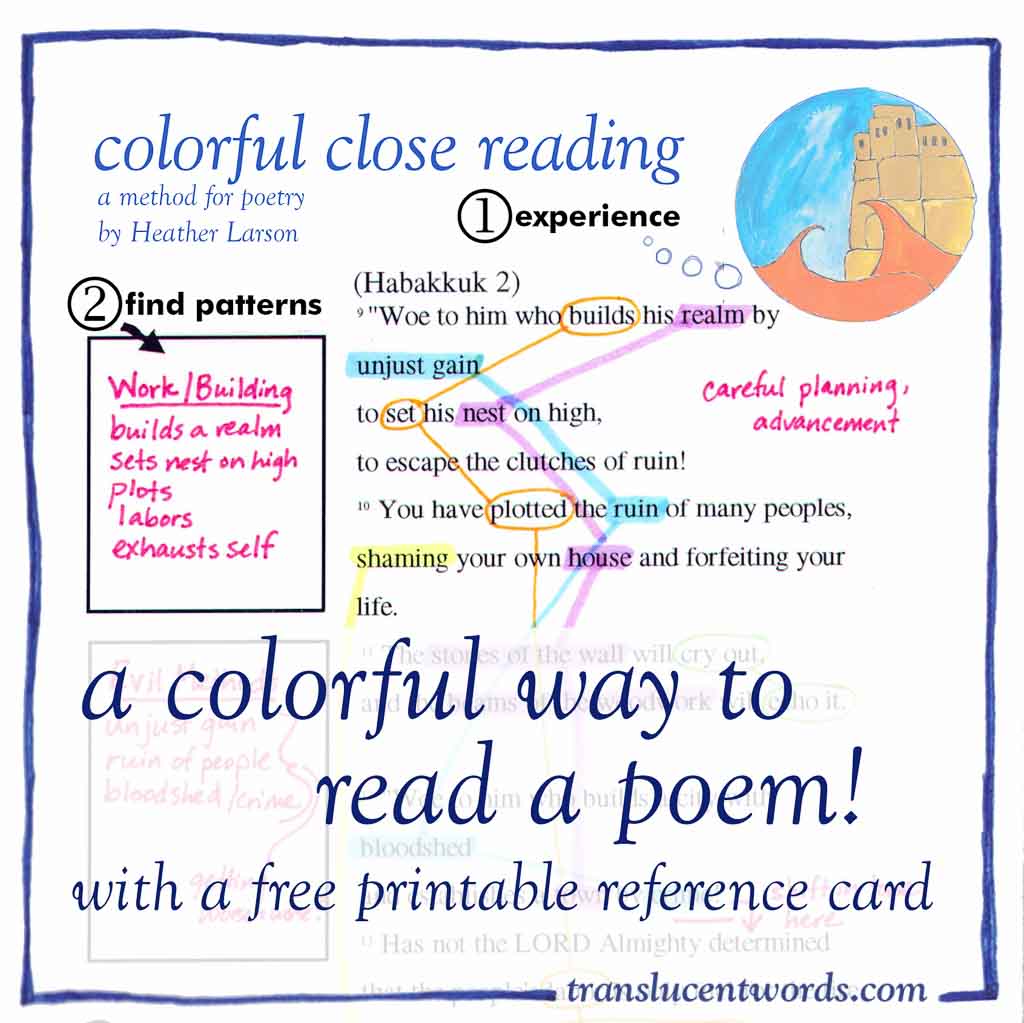How do you help a kid find something to write about a poem? How do you dig into a poem yourself, especially one you don’t “get”? And how do you find the beauty in densely poetic scripture texts? I use the same method for all three needs. It’s basically the method I taught to college students in introductory literature classes under the name “close reading.” And it’s also very close to the “inductive Bible study” method I learned in my college fellowship. So whichever you want to call it, and whichever you use it for, I’ll describe what I do, and give you a free printable reference card.
Step 1: Experience
Imagine the scene being described as carefully as you can. In the margins, note down your reactions. Make a note of anything that confuses you or troubles you. Ask yourself:
- What would it be like to be in this scene?
- What confuses me?
- What would the author most want me to remember?
Step 2: Find Patterns
Here is the moment where you break out the colored pens or highlighters! Go on a hunt for any kind of repetition–whether it’s of a word or a concept or category. And then, if it’s in its original language, look for repetition of sounds. Highlight the connections you find, and start to make lists in your margins. Ask yourself:
- What words are repeated? (circle/highlight and connect with lines)
- What words are closely related? (e.g. ‘red,’ ‘blue,’ and ‘yellow’)
- Are there opposites or contrasts?
- What are all the nouns? verbs? characters? places? sounds? sights? smells? (choose whichever seems most relevant in this poem)
- What does the passage sound like? How does it flow, where are shifts?
- What emotions does it communicate? (read it aloud, dramatically)
Step 3: Analyze
Once you have found patterns or noted basic observations, you are ready to try to see what they mean. Your goal now is to try to figure out what the poet was doing with those patterns you found. Ask yourself:
- What are the repeated elements supposed to make me feel or know?
- Is there a progression in the closely related words? (e.g. they’re getting closer to home, or more and more frightening)
- How does the flow of the poem reinforce/change the meaning?
- How does the sound of the poem reinforce/change the meaning? (e.g. all the long “oo” sounds make it feel sleepy)
- How would I divide this poem into sections?
Step 4: Find Context
If you found patterns and could see how the poet was using them to create an effect, congratulations, you have something to write! It is usually helpful, though, to look a little at the context and extend your understanding. Ask yourself:
- What is the form of this poem? (e.g. sonnet, psalm) How is that form usually used?
- How would this poem have been received originally? (oral presentation, handwritten manuscript, published in a magazine, sung) How does my knowledge of the presentation or audience affect the meaning of the passage?
- Are there obviously “loaded” terms for which I need some cultural context?
- When I compare this poem to others in the same genre, do I find surprises? (e.g. most lament psalms end in a certain way, but this one doesn’t)
- When I compare this passage to others in the same cultural context, are there any meanings implied by juxtaposition? (e.g. if the culture often used the word “milk” in passages about death, it might carry that connotation even though it wasn’t explicit)
Step 5: Apply
Having met the poem on its own terms, it’s time to consider its effect on you. Ask yourself:
- Do I agree or disagree with the poet?
- Has it changed me in any way?
- Do I want to change my life in any way in response?
That’s It!
So, those are my five steps. Be sure to download the free printable prompt card: ColorfulCloseReading.
…and to let me know if you have ideas to add to my list!


Journaling Bible: My Process | Translucent Words
[…] with the kind of word-analysis and notes I’ve enjoyed for a long time (as I shared in this post), and which is also rather visual. I did find some examples along these lines, and especially […]